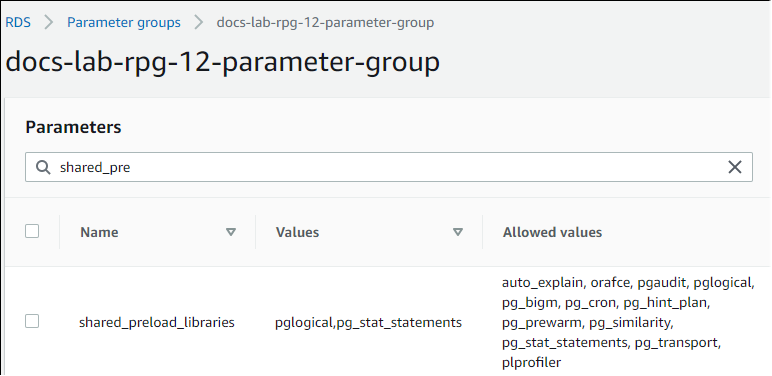Setting up the pglogical extension
To set up the pglogical extension on your
Aurora PostgreSQL DB cluster, you add pglogical
to the shared libraries on the
custom DB cluster parameter group for your Aurora PostgreSQL DB
cluster. You also need to set the value of the rds.logical_replication
parameter to 1, to turn on logical decoding. Finally, you create the extension in
the database. You can use the Amazon Web Services Management Console or the Amazon CLI for these tasks.
You must have permissions as the rds_superuser role to perform these
tasks.
The steps following assume that your Aurora PostgreSQL DB cluster is associated with a custom DB cluster parameter group. For information about creating a custom DB cluster parameter group, see Parameter groups for Amazon Aurora.
To set up the pglogical extension
Sign in to the Amazon Web Services Management Console and open the Amazon RDS console at https://console.amazonaws.cn/rds/
. -
In the navigation pane, choose your Aurora PostgreSQL DB cluster's Writer instance .
-
Open the Configuration tab for your Aurora PostgreSQL DB cluster writer instance. Among the Instance details, find the Parameter group link.
-
Choose the link to open the custom parameters associated with your Aurora PostgreSQL DB cluster.
-
In the Parameters search field, type
shared_preto find theshared_preload_librariesparameter. -
Choose Edit parameters to access the property values.
-
Add
pglogicalto the list in the Values field. Use a comma to separate items in the list of values.
-
Find the
rds.logical_replicationparameter and set it to1, to turn on logical replication. -
Reboot the writer instance of your Aurora PostgreSQL DB cluster so that your changes take effect.
-
When the instance is available, you can use
psql(or pgAdmin) to connect to the writer instance of your Aurora PostgreSQL DB cluster.psql --host=111122223333.aws-region.rds.amazonaws.com --port=5432 --username=postgres--password --dbname=labdb -
To verify that pglogical is initialized, run the following command.
SHOW shared_preload_libraries;shared_preload_libraries -------------------------- rdsutils,pglogical (1 row) -
Verify the setting that enables logical decoding, as follows.
SHOW wal_level;wal_level ----------- logical (1 row) -
Create the extension, as follows.
CREATE EXTENSION pglogical;EXTENSION CREATED -
Choose Save changes.
Open the Amazon RDS console at https://console.amazonaws.cn/rds/
. -
Choose your Aurora PostgreSQL DB cluster's writer instance from the Databases list to select it, and then choose Reboot from the Actions menu.
To setup the pglogical extension
To setup pglogical using the Amazon CLI, you call the modify-db-parameter-group operation to modify certain parameters in your custom parameter group as shown in the following procedure.
-
Use the following Amazon CLI command to add
pglogicalto theshared_preload_librariesparameter.aws rds modify-db-parameter-group \ --db-parameter-group-namecustom-param-group-name\ --parameters "ParameterName=shared_preload_libraries,ParameterValue=pglogical,ApplyMethod=pending-reboot" \ --regionaws-region -
Use the following Amazon CLI command to set
rds.logical_replicationto1to turn on the logical decoding capability for the writer instance of the Aurora PostgreSQL DB cluster.aws rds modify-db-parameter-group \ --db-parameter-group-namecustom-param-group-name\ --parameters "ParameterName=rds.logical_replication,ParameterValue=1,ApplyMethod=pending-reboot" \ --regionaws-region -
Use the following Amazon CLI command to reboot the writer instance of your Aurora PostgreSQL DB cluster so that the pglogical library is initialized.
aws rds reboot-db-instance \ --db-instance-identifierwriter-instance\ --regionaws-region -
When the instance is available, use
psqlto connect to the writer instance of your Aurora PostgreSQL DB cluster.psql --host=111122223333.aws-region.rds.amazonaws.com --port=5432 --username=postgres--password --dbname=labdb -
Create the extension, as follows.
CREATE EXTENSION pglogical;EXTENSION CREATED -
Reboot the writer instance of your Aurora PostgreSQL DB cluster using the following Amazon CLI command.
aws rds reboot-db-instance \ --db-instance-identifierwriter-instance\ --regionaws-region